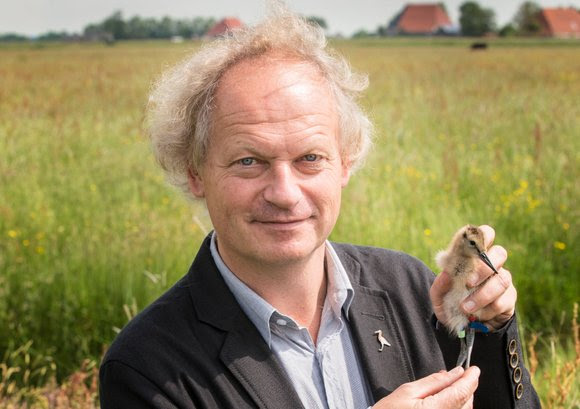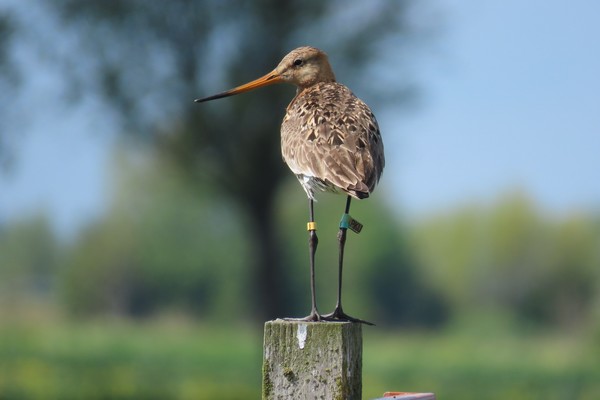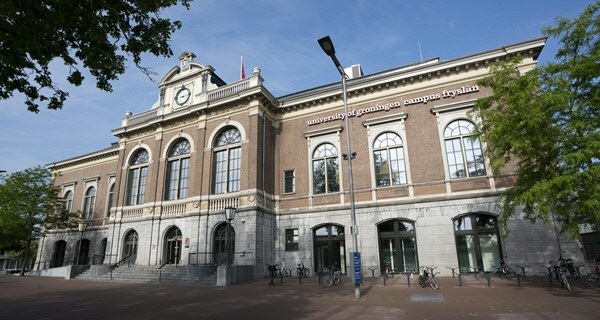Vogels gaan verhaal van het wad vertellen
De natuur in het Waddengebied staat onder druk, maar wat precies de gevolgen zijn van klimaatverandering, toerisme, milieuvervuiling of zeespiegelstijging is onduidelijk. Aan de hand van zes vogelsoorten willen onderzoekers van de RUG, het NIOZ en de Universiteit van Amsterdam uitzoeken wat er mis gaat, en welke beschermingsmaatregelen werken. Ook kunstenaars spelen daar een rol bij.
FSE Science Newsroom | René Fransen
Hoogleraar Trekvogelecologie Theunis Piersma onderzoekt al zijn hele leven de vogels die door de Waddenzee trekken. Van West Afrika tot Groenland of Siberië volgde hij kanoeten en andere soorten. Nu is hij een van de trekkers van het project Waakvogels, dat vijf jaar lang informatie zal verzamelen over zes soorten die de Waddenzee aandoen. Daarmee zetten Piersma en zijn collega’s werk voort dat al in 2012 (en voor sommige soorten nog langer geleden) is gestart.
(lees door onder de foto)

Inhaalslag
‘De trekvogels vertellen ons iets over de toestand van het Wad’, legt Piersma uit. Door nauwkeurig te meten hoe het deze vogels jaar in jaar uit vergaat is het mogelijk te bestuderen wat bijvoorbeeld de impact van klimaatverandering is. ‘De drieteenstrandloper deed het bijvoorbeeld de laatste jaren verrassend goed. Ons onderzoek liet zien dat door klimaatverandering garnalen eerder op de wadplaten verschijnen, en die zijn juist voor de drieteen een belangrijke voedselbron.’
Om dit soort trends te ontdekken zijn langlopende metingen nodig van allerlei factoren. Eerder gebeurde dat met het project Metawad (2012-2016). ‘Daarna was er geen bereidheid dit werk te financieren en lag het zo’n zeven jaar grotendeels stil, we probeerden natuurlijk wel een aantal meetseries door te zetten. Alleen het dure uitwerken en publiceren lukte niet meer.’ Via Waakvogels gaat dit werk, met een inhaalslag, nu verder.
BirdEyes
Voor het onderzoek zijn soorten uitgekozen die elk een ander biotoop van het Wad benutten. Vijf zijn ook al in de gaten gehouden via Metawad: de Rotgans, die zeegras eet van de wadplaten en gras in polders en op de kwelders, de Drieteenstrandloper die op wadplaten maar ook langs het strand voedsel zoekt, de Rosse Grutto die op het open wad vooral op wormen leeft, de schelpdieren etende Kanoet en ten slotte de Lepelaar, die hier broedt en foerageert in geulen op het Wad, maar ook in zoet water. Als zesde is de grutto toegevoegd, een weidevogel die in 2015 tot ‘nationale vogel’ van Nederland is verkozen.
(Lees door onder de foto)

Het monitoren van deze vogels is een klus die te groot is voor een gewone onderzoeksgroep. Bovendien zijn het trekvogels, dus ook de gebieden waar ze overwinteren en broeden spelen een rol. Piersma heeft daarom eerder het onderzoekscentrum BirdEyes opgericht. Dat is gehuisvest in Leeuwarden, als interfacultaire brug tussen de Faculteit Science en Engineering en Campus Fryslân. In het centrum werkt de RUG samen met het Koninklijk Nederlands Instituut voor Zeeonderzoek (NIOZ), de Universiteit van Amsterdam en de Fryske Akademy.
Satellietzenders
‘We zitten daar mooi centraal, goed bereikbaar vanuit Amsterdam en vanaf Texel, waar het NIOZ zit, en dicht bij het Waddengebied’, vertelt Piersma. ‘En zowel provincie, de Waddenacademie als het Waddenfonds zitten om de hoek. Dat zorgt voor een mooie dynamiek.’ De partners van BirdEyes trekken ook het Waakvogel programma. ‘Iedereen vond het belangrijk dat ons werk werd voortgezet. We hebben nu financiering voor vijf jaar, en de ambitie is om dat door te laten lopen; dat het populatiewerk onderdeel wordt van de Basismonitoring Waddengbied.’ Bijna de helft van de in totaal tien miljoen gaat naar RUG onderzoekers.
Een belangrijk deel van het onderzoek gebeurt met zendertjes: satellietzenders waarmee vogels tijdens de trek zijn te volgen, maar ook tijdelijke plakkertjes die opgepikt worden door een netwerk van antennes op het Wad, om de dagelijkse bewegingen daar te monitoren. De satellietzenders zijn al jaren in gebruik binnen het Global Flyway Network programma, de plakkertjes komen uit het WATLAS programma van het NIOZ.
(lees door onder de foto)

Siberië
Het is de bedoeling om niet alleen goed onderzoek te gaan doen, Piersma wil het ook op de best mogelijke manier de resultaten delen. ‘Daarvoor willen we samenwerken met narratieve kunstenaars.’ Hij deed dit zelf al eerder, bijvoorbeeld in 2017 tijdens Oerol, waar hij samen met componist en geluidskunstenaar Sytze Pruiksma optrad. ‘Binnen Waakvogels gaan we een summerschool organiseren, waar jonge onderzoekers gaan samenwerken met kunstenaars om de verhalen over hun werk te vertellen.’ Daarnaast verbeteren kunstenaars ook het onderzoek, vindt Piersma: ‘Ze helpen ons op onverwachte wijze om de belangrijke vragen en de grote lijn te vinden.’
‘Het is juist inspirerend te zien hoe vogels zich weten aan te passen.'
Het onderzoek richt zich op de bedreigingen van het Waddengebied. Dat klinkt zwaar, maar Piersma ziet dat anders. ‘Het is juist inspirerend te zien hoe vogels zich weten aan te passen. Zij kijken namelijk goed naar de wereld.’ Het idee was bijvoorbeeld dat de Rosse Grutto, die in Siberië broedt, zich slecht zou kunnen aanpassen. ‘Maar wij zagen een voortdurende aanpassing, de vogels leerden van elkaar, in een echte gemeenschap.’
Al weten we dat ze ons veel te vertellen hebben, het luisteren hebben we nauwelijks gedaan, veel te weinig om onderbouwde uitspraken te doen over wat er nu aan de hand is op en rond het Wad. ‘Dat is de uitdaging van ons project.’ De zes vogelsoorten moeten laten zien wat er aan de hand is, en of maatregelen die de natuur moeten beschermen ook echt werken. ‘We willen het beste onderzoek op de beste manier vertellen’, besluit Piersma. ‘Met dynamische verhalen, die de menselijke en niet-menselijke bezoekers van dit gebied een rijkere wereld bezorgen.‘
Meer nieuws
-
02 december 2025
Student Menna Zahran wint Unilever Research Prize
-
27 november 2025
Vliegtuigen spotten met een radiotelescoop
